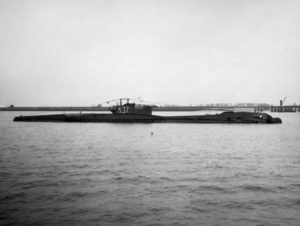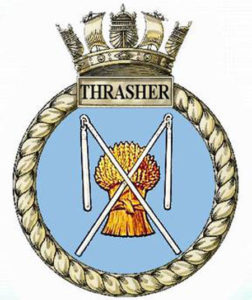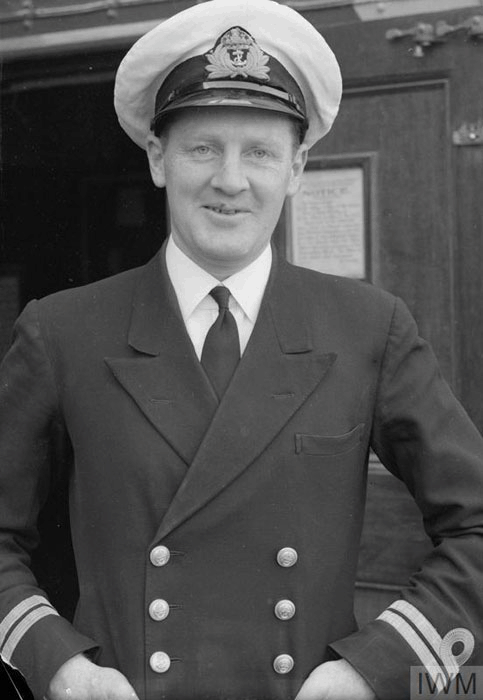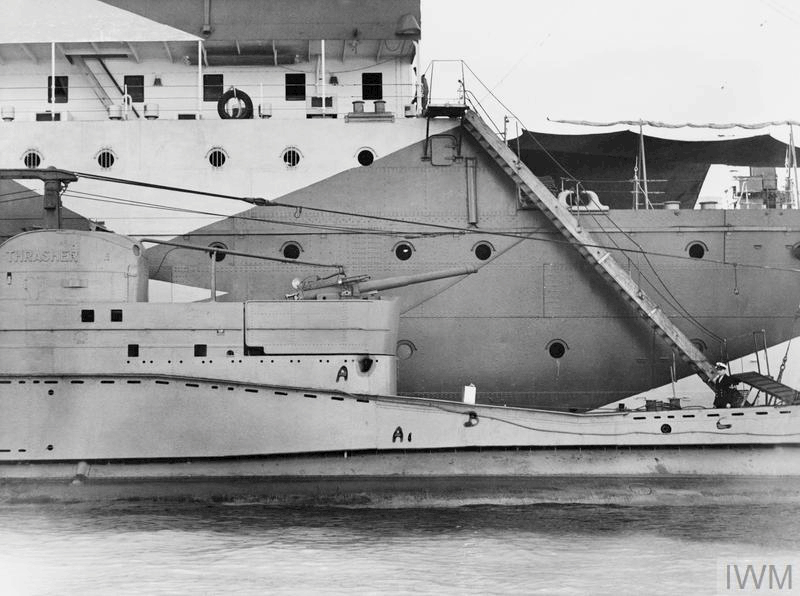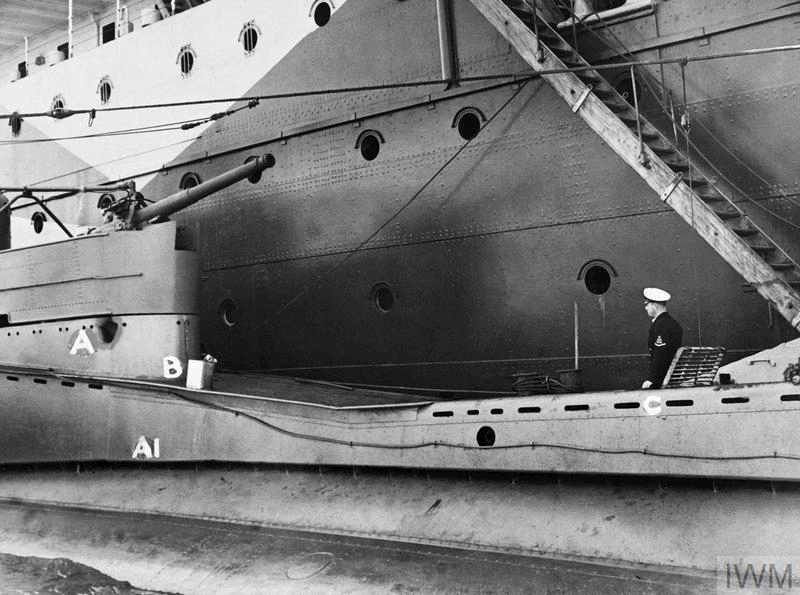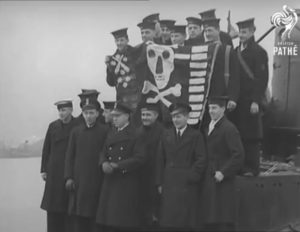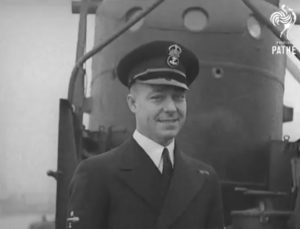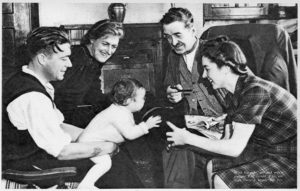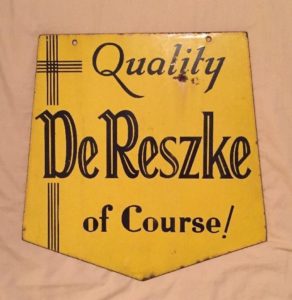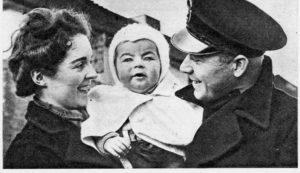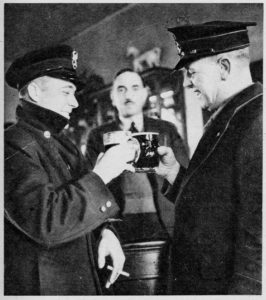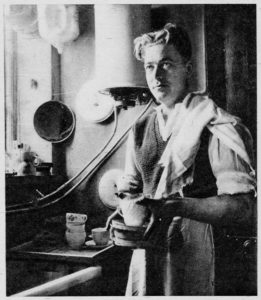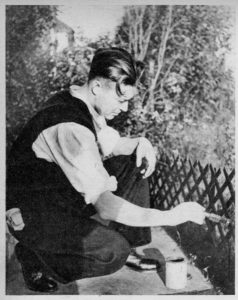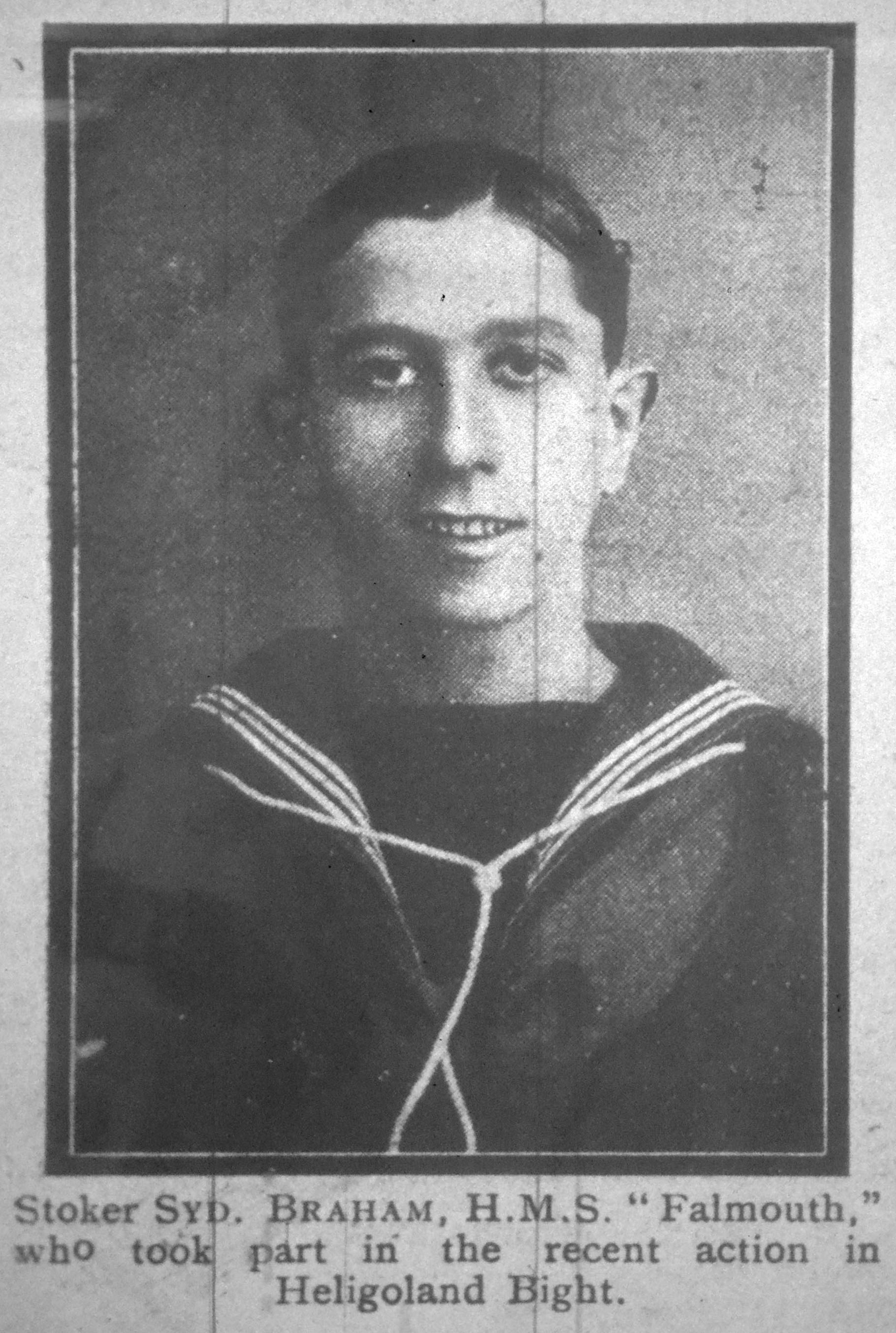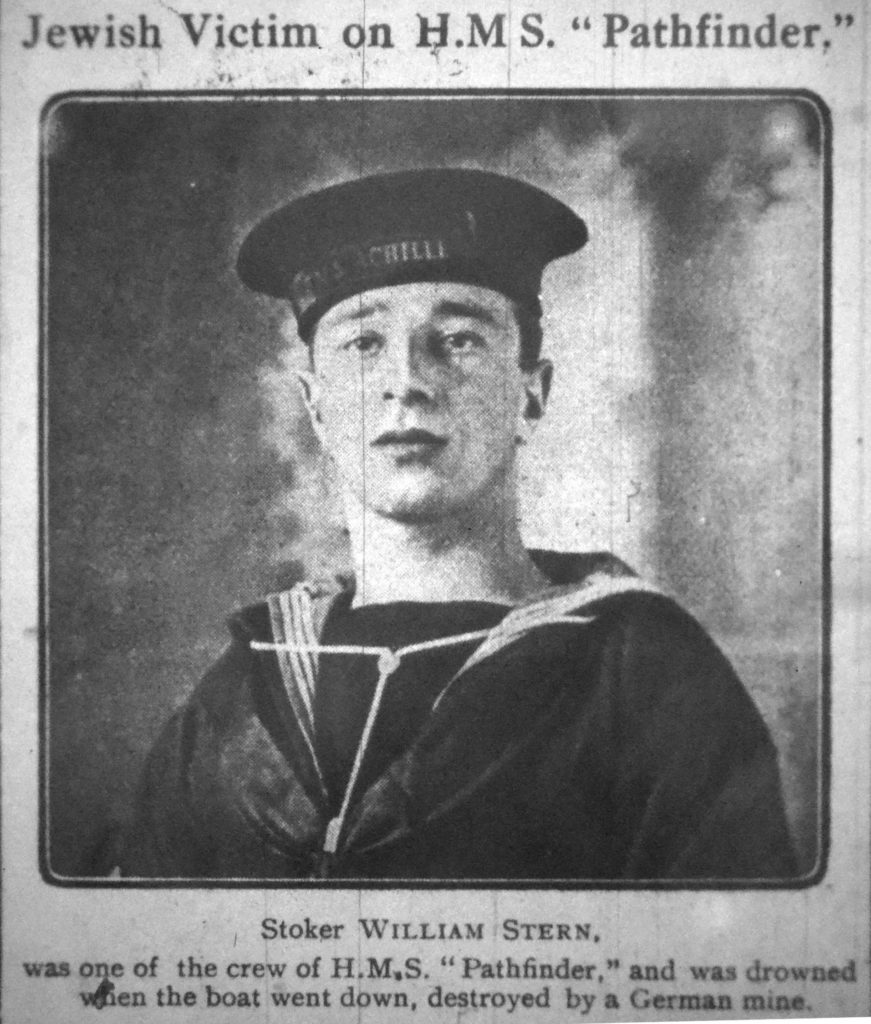Thus for Tommy Gould’s life before war: but what came before? This too is a story in its own right, but one that – with the passage of time and absence of records and correspondence – may likely remain only partially known.
As noted in Tommy Gould’s obituary in the Independent, and in more detail in his biographical profile at RN Subs, his father Reuben was killed in action in 1916, when Tommy was only two years old.
This singularly significant “clue” – a first name and surname – is all that is needed to return the following record from the CWGC database:
Reuben Gould
Serjeant GOULD, REUBEN
Service Number L/7328
Died 22/07/1916
Aged 35
1st Bn., Queen’s Own (Royal West Kent Regiment)
Husband of Mrs. C.E. Cheeseman (formerly Gould), of 6, Woolcomber Lane, Dover.
Buried at CATERPILLAR VALLEY CEMETERY, LONGUEVAL
Location: Somme, France – XIV, F, 2
So, it was true: Tommy Gould’s father lost his life in the Battle of the Somme. He was among the 141 men of the 1st Battalion, Royal West Kent Regiment who were killed in action, or died of wounds (among an initial total of 391 killed, wounded, and missing) on July 22, 1916, during a series of assaults on the German trenches at High Wood.
A verbatim transcript of the War Diary / Intelligence Summary of the R.W.K.R., 1st Battalion for that day – found within UK WW I War Diaries at Ancestry.com – is presented below. Note that the account concludes with details about casualties among officers, but not – perhaps inevitably, given the staggering number of killed and wounded – among Ordinary Ranks. Which, would have included Serjeant Gould.
This is the “cover” page of the War Diary….
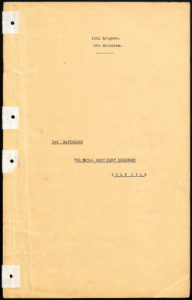 ….and this is the “first” page of eight, covering events of July 22, 1916.
….and this is the “first” page of eight, covering events of July 22, 1916.
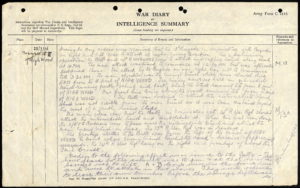 During the day orders were received that the 13th Brigade in conjunction with Brigades on right and left was to attack at night Enemy position. As a preliminary operation the Battn. and 14th WARWICKS were to attack and capture trench along road at 10 PM. The main attack was timed to commence at 12:30 AM but was afterwards postponed 1 hour. The attack by the Brigade on our right was not to commence till 3:30 AM. The main objective was the Enemy’s trench which runs almost due EAST from the N part of HIGH WOOD. The Enemy however held an intermediate trench running partly behind and partly along the track running SE from E point of HIGH WOOD. Our front line along the track running SE from S point of HIGH WOOD. The Battn. was ordered to attack this intermediate trench, which was not visible from its own trench as it was some distance beyond the crest of a gently rising slope.
During the day orders were received that the 13th Brigade in conjunction with Brigades on right and left was to attack at night Enemy position. As a preliminary operation the Battn. and 14th WARWICKS were to attack and capture trench along road at 10 PM. The main attack was timed to commence at 12:30 AM but was afterwards postponed 1 hour. The attack by the Brigade on our right was not to commence till 3:30 AM. The main objective was the Enemy’s trench which runs almost due EAST from the N part of HIGH WOOD. The Enemy however held an intermediate trench running partly behind and partly along the track running SE from E point of HIGH WOOD. Our front line along the track running SE from S point of HIGH WOOD. The Battn. was ordered to attack this intermediate trench, which was not visible from its own trench as it was some distance beyond the crest of a gently rising slope.
The main idea was that the Battn in conjunction with 14th R War Regt should attack the intermediate trench and consolidate it. When this had been done the 2 / K.O.S. Borderers were to pass over the intermediate trench and attack the main enemy trench in rear. The 15th R. War. Regt was in reserve.
The frontage allotted to the Battn was from the left of the trench at HIGH WOOD to point where enemy trench touched the road, a distance of approximately 400 yards. The 14th R. War Regt being on the right on a frontage of about the same breadth.
Orders to the following effect were issued to the Battn.: The hour fixed for the assault was 10 pm. & at that hour the barrage was to lift. A & B Coy’s were in the front line and were to attack in two waves. They were ordered to leave their own trenches before the barrage lifted and to get as close to the enemy trench as possible so that when the barrage lifted they could dash in. The second waves of these boys were to carry entrenching tools which were to be left as close to the enemy trench as possible before final assault. C Coy were ordered to occupy our original front line at 10 pm and as soon as enemy trench was captured they were to dig a support trench joining up the advance posts already made in front of our line. This Coy was also to join up E corner of HIGH WOOD with the captured trench. O.C. Coy had also to detail a bombing party under an Officer to seize enemy strong point at E corner of HIGH WOOD should such strong point be found to be held by enemy. The existence of this strong point was known of, but the Division on the left guaranteed to deal with it previous to the assault, and it was afterwards stated that we had 2 Vickers Guns in position at the E edge of HIGH WOOD. At the last moment, however, doubt arose as to the situation at this strong point, and in consequence of vagueness and uncertainty that existed, this party was detailed as an extra precaution. D Coy was ordered to occupy our front line trenches as soon as vacated by C Coy but to keep well to the left in order that the 2 / KOSB could use this trench as an assembly trench previous to their attack on main position. 2nd Lt. Dando with bombing party was ordered to accompany the first line on extreme left and investigate a short line of enemy trench which ran at right angles to & on the left of & beyond their front trench. If opposition was met he was to block this trench and wait till 2 / KOSB passed through, when he was to advance and seize it. C & D Coys, in spite of above orders, were to be prepared to support A & B Coys should necessity arise and in that case all work allotted to them was to be left. The position of Battn H.Q. was not to change. Each man carried two Mills Bombs (to form a reserve in captured trench) and an extra bandolier of ammunition. Communication to be by visual signaling (if smoke permitted) and by runner. Covering parties were to be put out directly position was captured. Wire for consolidating captured trench was to be carried up by D Coy. The attack was to be pressed home at all costs.
At the same time as this attack other Divisions were attacking on the left and the 95th Bde. Was to attack DELVILLE WOOD, but the latter operation could not be commenced until we had gained our objective.
A & B Coys left their own trenches at 9.52 pm and advanced without many casualties until arriving near the road on the crest of the hill, when they were met with extremely heavy rifle & M. Gun fire from direction of E corner of HIGH WOOD and enemy trenches N of Wood, but also suffered casualties by shells from our own Artillery falling short. Only two parties of these boys reached the enemy trenches. On the right about 30 men of A Coy reached enemy trench and entered it, but were attacked by the enemy with bombs, as the 14th R. WAR. on their right had failed to reach the trench, and as their own supply of bombs soon ran short they could not maintain their position. All the officers of this Coy. had become casualties. On the left Lt. J.J. SCOTT with 21 men of his Platoon entered the enemy trench and killed some Germans. Lt. SCOTT put out patrols in front, generally consolidated the position for a length of about 40 yds., and held on to it for about 4 hours. The enemy attempted a bombing attack on the left but this was frustrated by Pte. BUTLIN, who, stepping over the enemy bombs before they exploded, threw bombs of his own and drove the enemy back. These were the only two parties to reach enemy’s trench. C & D Coys both went up to reinforce, and later on a part of 2 / KOSB & 2 Coys of 15th R. WAR.R. were sent forward but the latter lost direction. Some reached enemy line but eventually all troops were withdrawn to our original front line. The bombing party of C. Coy, sent against the strong point in HIGH WOOD, found the corner of wood already in occupation by the Brigade on left, but it is believed that it was retaken by enemy. Lt. PEACHEY in command of party was himself wounded. It is however probably that the strong point itself was never reached and was further back from the corner than was supposed. In any case, the majority of the casualties in the Battn. were caused by M. Gun fire from here. Lt. DANDO with his party did not find the isolated trench on the left flank and returned to H.Q. to report the situation. He afterwards went forward again and brought back a further report. Lt. HEALEY, the Adjutant, was sent forward to reorganize parties who were in front of our trenches and bring them back to our original front line. He was, however, wounded when near the German trenches, and could not be brought in. Lt. CALE, Lewis Gun Officer, also reached the German trenches and assisted in reorganising the line.
Eventually some 250 men were collected by Capt. WRIGHT in our original front line.
On our right, 14th R. WAR. R. were met by a sustained fire of bombs & rifle & M.Gun fire, and did not reach the enemy’s trench.
The Casualties amounted to
Officers
Killed – Missing – Wounded:14 (See below)
O.R. [Other ranks]
Killed – Missing – Wounded377
The individual casualties among officers were as follows: –
A Coy
Capt. COBB, W.R. was wounded very early in the fight
2 Lt. FLEMING, J.A. was wounded & missing [CWGC KIA “John Allister”]
2 Lt. CORNFORD, W.D. was missing [CWGC KIA “William Day”]
2 Lt. LEWINSTEIN, H. was killed by a bomb [CWGC “Harry”]
B Coy
Capt. BENNETT, C.T. was wounded & missing [CWGC KIA “Charles Tudor”]
Capt. LEATHERDALE, D.R. was missing
2 Lt. FOX, C.J. was killed
C Coy
Capt. OGLE, W.M. was wounded
Lt. BULLEN, G. was wounded
2 Lt. PEACHEY, G.F. was wounded
2 Lt. CROSS, P.F. was wounded & missing [CWGC KIA “Philip Frank”]
D Coy
Lt. BARTLETT, L.A. was missing [CWGC KIA “Lionel”]
2 Lt. GILLETT, F. was killed
H. Qrs.
Lt. HEALEY, R.E.H. was wounded & missing [CWGC KIA “Richard Elkanah Hownam”]
Many acts of gallantry were performed, the following being the most conspicuous: –
No. 7725 Corporal GEORGE HATCH.
The Battn. when advancing to the assault of the German trenches, came under very heavy machine gun and shell fire and a large number of men were wounded. As the intensity of the fire did not diminish it was impossible for the stretcher bearers to go out and collect wounded. However Cpl. HATCH, who was in charge of the stretcher bearers, went out by himself, walked about in the open and carried wounded to cover in shell holes. This was done some 200 yards in front of our own lines and within very close range of the enemy machine guns. He afterwards carried back many of the men to our own line. He continued his work with the utmost coolness and disregard for personal safety for about 7 hours and until well after daylight when eventually he was himself wounded. He was under very heavy fire the whole time. He was seen to carry back at least 50 cases, and there is no doubt that he saved the lives of a large number of men.
______________________________
A search of Google Maps for the above-listed “6 Woolcomber Lane, Dover” yielded the following three maps, showing at successively larger scales southeastern England, then Dover, and finally Woolcomber Street (formerly Lane?) in Dover. Notably, while the map shows the nominal and presumably original location of the street, a 2018 aerial view of the same location reveals that none of the dwellings that presumably once existed there remain standing, a parking lot having taken their place.


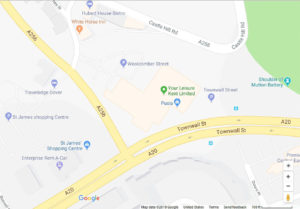
 An effort to find more information about Serjeant Gould’s family revealed the record below, from the 1911 Census of England and Wales. (Thanks, Ancestry.com!) Intriguingly, though there is no entry for Reuben Gould, it appears that Reuben’s wife – Tommy Gould’s mother? – appears as “Christian Elmer [Almer?] Gould, age 26. Christian is the daughter of Maria Mary Anna Irons (58 years old), and the mother of Sidney Robert Gould (age 1/ ½ years; Tommy’s older brother?) and sister of Morris William Irons, age 16 ½.
An effort to find more information about Serjeant Gould’s family revealed the record below, from the 1911 Census of England and Wales. (Thanks, Ancestry.com!) Intriguingly, though there is no entry for Reuben Gould, it appears that Reuben’s wife – Tommy Gould’s mother? – appears as “Christian Elmer [Almer?] Gould, age 26. Christian is the daughter of Maria Mary Anna Irons (58 years old), and the mother of Sidney Robert Gould (age 1/ ½ years; Tommy’s older brother?) and sister of Morris William Irons, age 16 ½.
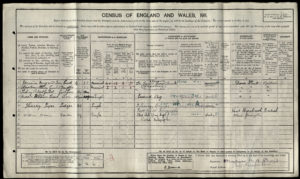 Being that Tommy Gould was born in 1914, his name by definition would not appear in this Census.
Being that Tommy Gould was born in 1914, his name by definition would not appear in this Census.
Notably, the document was completed by Maria Irons, who lists, below her signature, the address as 5 (not 6) Woolcomber Lane.
Reuben’s British Army WW I Medal Roll Index Card is presented below…
 …and here is the Graves Registration Report for Caterpillar Valley Cemetery, with Reuben’s name appearing second from top. Notable is his designation as a Private (not a Serjeant, as listed in the CWGC record and Medal Roll Index Card), and the fact that his tombstone bears a Crucifix – not a Magen David – which presumably would indicate the religious affiliation he designated upon entering the Army.
…and here is the Graves Registration Report for Caterpillar Valley Cemetery, with Reuben’s name appearing second from top. Notable is his designation as a Private (not a Serjeant, as listed in the CWGC record and Medal Roll Index Card), and the fact that his tombstone bears a Crucifix – not a Magen David – which presumably would indicate the religious affiliation he designated upon entering the Army.
 If so – it may be so; it certainly seems so – this is reflective of the plethora of anecdotes, news items, and lengthy opinion pieces appearing in The Jewish Chronicle throughout the First World War – written by “ordinary ranks” as well as officers, rabbis, community leaders, intellectuals, and other public figures – pertaining to the decision by some Jewish servicemen to identify their religious affiliation as other than such upon entering the military. This topic was also addressed in the American Jewish Press during America’s involvement in the war.
If so – it may be so; it certainly seems so – this is reflective of the plethora of anecdotes, news items, and lengthy opinion pieces appearing in The Jewish Chronicle throughout the First World War – written by “ordinary ranks” as well as officers, rabbis, community leaders, intellectuals, and other public figures – pertaining to the decision by some Jewish servicemen to identify their religious affiliation as other than such upon entering the military. This topic was also addressed in the American Jewish Press during America’s involvement in the war.
Every man is an individual, subject to and both the captain and captive of his own strengths and weaknesses; his own fears and hopes; his own life experiences and observations. Such decisions would have been motivated by the same set of conundrums that have confronted the Jewish people ever since the beginning of Jewish emancipation only a few centuries ago: The desire to avoid antisemitism; the natural, universal, perennial human desire to want to smoothly belong to a “group” – any group – be that group military, civilian, or familial – without “rocking the boat”; pure self-interest; and even more than realized, a degree of acculturation and assimilation that would gradually and bear-inevitably have moved the centrality of Jewish identification – in time irrelevant or muted – to the quiet periphery of one’s life and priorities.
Far, far more could be said about this topic. Vastly amounts have already been written. Even in and after 2018, more will follow. But two excellent monographs on the subject – enlightening and disturbing; illuminating and disillusioning; revelatory and astute – are the late Barry Rubin’s Assimilation and Its Discontents (Times Books, 1995) and Radical Assimilation in English-Jewish History 1656-1945, by Todd M. Endelman (Indiana University Press, 1990).
In any event, though Serjeant Gould’s name did not appear in The Jewish Chronicle, or Reverend Michael Adler’s 1922 British Jewry Book of Honour, the names of two other serviceman – 2 Lt. Harry Lewinstein – (listed above) and Pvt. Hyman Rosenthall – did.
In its issue of 11 August 1916, as it did throughout the war, the Chronicle published the most recently available list of the names of Jewish soldiers reported killed, missing, wounded, and injured, or who died in service. Typical of WW I casualty lists presented in that newspaper, soldiers’ names are given in “descending” order by rank, with officers appearing first.
Importantly – exasperatingly, in terms of genealogical research! – throughout the war, the Chronicle rarely published a soldier’s full first (and middle, if any) name, instead using only his initials. I don’t know if this reflected the editorial policy of the Chronicle itself, or, was simply the format of Casualty Lists released by the War Office. In any event, the ambiguity inherent to some names can make the identification of specific, identically-named individuals more than challenging.
So, here is the Chronicle’s casualty list for August 11, showing (for the purposes of this post) only soldiers killed in action.
 Genealogical information covering Jewish soldiers killed in action on July 22, 1916 – as well as two Jewish soldiers wounded on that date, Sapper Myer Joseph Isaacs and Gunner Cyril N. Mandelson, both Australians – follows below….
Genealogical information covering Jewish soldiers killed in action on July 22, 1916 – as well as two Jewish soldiers wounded on that date, Sapper Myer Joseph Isaacs and Gunner Cyril N. Mandelson, both Australians – follows below….
Known Jewish Military Casualties – July 22, 1916
Killed
– .ת.נ.צ.ב.ה. –
Ben Kimoun, Maurice Mouchi, Soldat de 2eme Classe, Armée de Terre, Zouaves, 3eme Regiment de Zouaves
Number 11452, Class 1913, Matricule 1881, Recrutement Oran
France (Algérie)
Born in Oran, Algeria, 10/24/93
Killed by the enemy [Tué a l’ennemi]; France, Meuse, Bras
Place of burial unknown
l’Univers Israélite 9/28/17
Les Israelites dans l’Armée Francaise – 12
Le Livre d’Or du Judaisme Algérien (1914-1918) – 204
 Braver, Max, Soldat de 2eme Classe, Armée de Terre, Infanterie, 352eme Regiment d’Infanterie
Braver, Max, Soldat de 2eme Classe, Armée de Terre, Infanterie, 352eme Regiment d’Infanterie
Number 11135, Class 1915, Matricule 59, Recrutement 3eme Bureau, Seine
France (Roumanie)
Born in Craiova, Roumania, 12/2/77
Killed by the enemy [Tué a l’ennemi]; France, Somme, Assevillers
Necropole Nationale “Lihons”, Lihons, Somme, France – Tombe Individuelle, No. 1685
Les Israelites dans l’Armée Francaise – Not listed
Fraenkel, Bruno, Soldat, Deutsches Heer, 49 Infanterie Regiment, 2nd Bataillon, 6 Kompagnie
Born May 5, 1884, Berlin, Germany
Lived in Eberswalde
(Missing)
Place of burial unknown
Die Jüdischen Gefallenen Des Deutschen Heeres, Deutschen Marine Und Der Deutschen Schutztruppen 1914-1918 – Ein Gedenkbuch – 138
Gros, Arnold, Soldat de 2eme Classe, Armée de Terre, Artillerie, 13eme Regiment d’Artillerie de Campagne
Number 13716, Class 1917, Matricule 833, Recrutement 3eme Bureau, Seine
France
Born at 9eme Arrondissement, Paris, 9/19/97
Killed by the enemy [Tué a l’ennemi]; France, Somme, Mametz
Necropole Nationale “La Cote 80”, Etinehem, Somme, France – Tombe Individuelle, No. 750
Les Israelites dans l’Armée Francaise – 38
 Jonas, Emil, Soldat, Deutsches Heer, 252 Pioner Kompagnie
Jonas, Emil, Soldat, Deutsches Heer, 252 Pioner Kompagnie
Born Dec. 12, 1877, Hamburg, Germany
Lived in Altona
(Missing)
Place of burial unknown
Die Jüdischen Gefallenen Des Deutschen Heeres, Deutschen Marine Und Der Deutschen Schutztruppen 1914-1918 – Ein Gedenkbuch – 372
Kahn, Nathan, Soldat, Deutsches Heer, 1 Lazarett Trupp, Freiwilliger Krankenpflege
Born Jan. 18, 1884, Munchen, Germany
Lived in Altenstadt
Place of burial unknown
Die Jüdischen Gefallenen Des Deutschen Heeres, Deutschen Marine Und Der Deutschen Schutztruppen 1914-1918 – Ein Gedenkbuch – 292
Kronheim, Georg, Soldat, Deutsches Heer, 113 Infanterie Regiment, 2 Bataillon, 5 Kompagnie
Mrs. Rosa (Brodek) Kronheim (wife); 1 child, Winsstrasze 4, Berlin, Germany
Mr. and Mrs. Nathan and Maria Theresa (Lewinberg) Kronheim (parents), Berlin, Germany
Born May 31, 1879, Berlin, Germany
Lived in Berlin
Judischen Friedhof zu Weissensee, Berlzu, Germany
Hank, Sabine, and Simon, Hermann, Bis der Krieg uns lehrt, was der Friede bedeute [Until the War Teaches Us What Peace Means] Hentrich & Hentrich, Teetz, Germany, 2004, 79
Die Jüdischen Gefallenen Des Deutschen Heeres, Deutschen Marine Und Der Deutschen Schutztruppen 1914-1918 – Ein Gedenkbuch – 147
Lazarus, Hans Heinz, Soldat, Deutsches Heer, 223 Reserve Infanterie Regiment, 1 Bataillon, 1 Kompagnie
Born April 20, 1894, Munchen, Germany
Lived in Berlin
(Missing)
Place of burial unknown
Die Jüdischen Gefallenen Des Deutschen Heeres, Deutschen Marine Und Der Deutschen Schutztruppen 1914-1918 – Ein Gedenkbuch – 292
Lebenstein, Manfred, Soldat, Deutsches Heer, 3 Garde Grenadier Regiment, 3 Bataillon, 12 Kompagnie
Born August 3, 1886, Munchen, Germany
Lived in Charlottenburg
Kriegsgräberstätte in St.Quentin (Frankreich), Block 3, Grab 68
Die Jüdischen Gefallenen Des Deutschen Heeres, Deutschen Marine Und Der Deutschen Schutztruppen 1914-1918 – Ein Gedenkbuch – 292
Levi, Julius, Soldat, Deutsches Heer, 25 Reserve Infanterie Regiment, 2 Bataillon, 7 Kompagnie
Born May 21, 1878, Schluchtern, Germany
Lived in Kassel
Place of burial unknown
Die Jüdischen Gefallenen Des Deutschen Heeres, Deutschen Marine Und Der Deutschen Schutztruppen 1914-1918 – Ein Gedenkbuch – 330
Lewinstein, Harry, 2 Lt., British Army, Queen’s Own (Royal West Kent Regiment), 1st Battalion
Mr. and Mrs. Lewis and Fanny Lewinstein (parents), 22 Great Windmill St., London, W, England
Born London, England, 1889
KIA July 22, 1916
Caterpillar Valley Cemetery, Longueval, Somme, France – XXX,B,7
The Jewish Chronicle 8/11/16
British Jewry Book of Honour – 72
The 2017 Google Maps image below shows the contemporary appearance of the wartime home of the Lewinstein family: 22 Great Windmill Street, London, W., now the location of Soho Radio.
 Rosenthall, Hyman, Pvt., 28134, British Army, Northumberland Fusiliers, 16th Battalion
Rosenthall, Hyman, Pvt., 28134, British Army, Northumberland Fusiliers, 16th Battalion
Mr. Isaac Rosenthall (father), 44 Grafton St., Leeds, England
(also) 42 Whitlock St., Leeds, England
Born 1893
KIA July 22, 1916
Blighty Valley Cemetery, Authville Wood, Somme, France – III,E,1
British Jewry Book of Honour – 115
This image of Hyman Rosenthall appeared in The Jewish World (The Jewish Chronicle’s sister publication) on May 2, 1917. The image was recorded from 35mm microfilm – at the Dorot Jewish Division of the New York Public Library – using a digital SLR. (I don’t think The Jewish World has yet been digitized.)
 These two soldiers were wounded on July 22, 1916, but survived. Biographical information about them was found by reviewing their digitized Attestation Papers, via the website of the National Archives of Australia.
These two soldiers were wounded on July 22, 1916, but survived. Biographical information about them was found by reviewing their digitized Attestation Papers, via the website of the National Archives of Australia.
Isaacs, Myer Joseph, Sapper, 1288, Australian Imperial Forces, 3rd Tunneling Company
Wounded in France
Mrs. Ruby Isaacs (wife), Mayville, Tupper St., Marrickville, New South Wales, Australia
Born Sydney, New South Wales, Australia, 1885
WIA July 22, 1916
British Jewry Book of Honour – 558
Attestation Papers list religion as “Jewish”; Civilian trade: Fitter
Mandelson, Cyril Nathaniel, Gunner, 3972, Australian Imperial Forces, 1st Field Artillery Brigade, Trench Mortar Battery
Wounded at Pas de Calais, France
Mr. Joseph Mandelson (father), 101 Victoria St., Darlinghurst, New South Wales, Australia
Born Sydney, New South Wales, Australia, 1887
WIA July 22, 2916
British Jewry Book of Honour – 561
Attestation Papers list religion as “Jewish”; Civilian trade: Agent; Married: Ruby Jane Hannah Mandelson
Genealogical information about the ten other soldiers whose names appear in the Chronicle’s casualty list – aside from 2 Lt. Levinstein and Pvt. Rosenthall – follows:
Casualty List – The Jewish Chronicle – August 11, 1916
– .ת.נ.צ.ב.ה. –
Baum, Harry Hyman, L/Cpl., 22701, British Army, Border Regiment, 1st Battalion
Mr. and Mrs. Nathan and Leah Baum (parents), Stepney, London, England
(also) 7 Dempsey St., London, E, England
Born 1894
KIA July 3, 1916
Louvencourt Military Cemetery, Somme, France – Plot I, Row D, Grave 2
The Jewish Chronicle 8/11/16
British Jewry Book of Honour – 79
Cohen, John, Rifleman, 5467, British Army, Rifle Brigade, 1st Battalion
86 Boundary St., Shoreditch, London, E, England
KIA July 1, 1916
Thiepval Memorial, Somme, France – Pier and Face 16B and 16C
The Jewish Chronicle 8/11/16
British Jewry Book of Honour – 84
Davis, J., Rifleman, R/15167, British Army, King’s Royal Rifle Corps, 13th Battalion
42 Vallance Road, London, E, England
KIA July 10, 1916
Gordon Dump Cemetery, Ovillers-la-Boisselle, Somme, France – VII,Q,2
The Jewish Chronicle 8/11/16
British Jewry Book of Honour – 87
Gluckman, Samuel, Pvt., 6171, South African Infantry, 3rd Regiment
Mr. and Mrs. J. and J. Gluckman (parents), 61 Fortescue Road, Yeoville, Johannesburg, South Africa
(also) P.O. Box 66, Vereenigang, South Africa
Born 1900
KIA July 9, 1916
Thiepval Memorial, Somme, France – Pier and Face 4C
The Jewish Chronicle 8/11/16
British Jewry Book of Honour – 91
Jacobs, Joel, 2 Lt., British Army, Yorkshire Regiment, 5th Battalion
Mr. and Mrs. Michael and Pearl Jacobs (parents), Harringay, 52 Walter Road, Swansea, England
Born 1895
KIA July 20, 1916
La Laiterie Military Cemetery, Heuvelland, West-Vlaanderen, Belgium – VII,D,13
On Matzeva: “I WAS GUIDED BY THY COUNSEL AND AFTERWARD RECEIVED WITH THY GLORY”
The Jewish Chronicle 8/11/16, 7/28/16 (obituary)
British Jewry Book of Honour – 71
This picture of Lt. Joel Jacobs appeared in The Jewish World on August 23, 1916. Identical to that of Pvt. Rosenthall, the image was copied from microfilm via a digital SLR. Throughout the First World War, The Jewish World published several hundred portraits of Jewish servicemen of England and the Commonwealth countries, as well as more candid images of life in the military. The quality of these images varies enormously.
 Levy, Lewis, Pvt., 18418, British Army, Hampshire Regiment, 1st Battalion
Levy, Lewis, Pvt., 18418, British Army, Hampshire Regiment, 1st Battalion
Mrs. Sarah Levy (wife); Henry and Evie (children), 104 Eric St., Mile End Road, London, England
(also) 132 Bridge St., London, E, England
Mrs A. Levy, Mat, John, Mrs. Moss Harris, Mrs. Mark Harris, Mrs. L. Zimmerman, Mrs. R. Simmons, Morris, Kate, and Beck (brothers and sisters)
Born 1893
KIA July 1, 1916
Bertrancourt Military Cemetery, Somme, France – Plot I, Row G, Grave 13
On Matzeva: “NOBLY HE ANSWERED HIS DUTY’S CALL”
The Jewish Chronicle 8/11/16, 7/14/16 (obituary)
British Jewry Book of Honour – 104
Lewis, J., Pvt., 16891, British Army, Somerset Light Infantry, 8th Battalion
Mr. and Mrs. Lewis and Leah Lewis (parents), 11 Sandfield Road, Aberavon, Port Talbot, West Glamorgan, Wales
Born 1892
KIA June 29, 1916
Norfolk Cemetery, Becordel-Becourt, Somme, France – I,A,81
On Matzeva: “IN LOVING REMEMBRANCE FROM MOTHER, SISTER, BROTHER R.I.P.”
The Jewish Chronicle 7/21/16, 8/11/16
British Jewry Book of Honour – 105
Rubin, Jack, Pvt., 4583, South African Infantry, 9th Regiment
Mr. and Mrs. Morris and Sarah Rubin (parents), Cape Town, South Africa
Born 1894
KIA July 16, 1916
Dar Es Salaam War Cemetery, Tanzania – 2,A,14
On Matzeva: “MAY HIS DEAR SOUL REST IN PEACE”
The Jewish Chronicle 8/11/16
British Jewry Book of Honour – 115
Shilling, Harry, Pvt., 2267, British Army, London Regiment, 7th Battalion
Mrs. Eva Shilling (wife), 34 Peter St., Hightown, Manchester, England
(also) 16 Mount St., London, E2, England
Born 1881
KIA May 24, 1916
Aubigny Communal Cemetery Extension, Pas de Calais, France – I,C,24
On Matzeva: “IN LOVING MEMORY OF MY DEAR HUSBAND FROM HIS LOVING WIFE AND CHILDREN”
The Jewish Chronicle 8/11/16
British Jewry Book of Honour – 116
British Jewry Book of Honour gives surname as “Schilling”, while CWGC and LJC Casualty List give surname as “Shilling”
References
Thomas W. Gould
Biography (Military Art)
Biography (Royal Navy Subs)
Biography (Kent History Forum)
Obituary (Independent)
Place of Commemoration / Burial (FindAGrave)
Miscellaneous
Victoria Cross (Wikipedia)
Jewish Victoria Cross Recipients (London Jews in the First World War)
VC * GC Association (VCGCA)
Books
Adler, Michael, British Jewry Book of Honour, Caxton Publishing Company, London, England, 1922
Hank, Sabine, and Simon, Hermann, Bis der Krieg uns lehrt, was der Friede bedeute (Until the War Teaches Us What Peace Means) Hentrich & Hentrich, Teetz, Germany, 2004
Die Jüdischen Gefallenen Des Deutschen Heeres, Deutschen Marine Und Der Deutschen Schutztruppen 1914-1918 – Ein Gedenkbuch, Reichsbund Jüdischer Frontsoldaten, Forward by Dr. Leo Löwenstein, Berlin, Germany, 1932
Les Israelites dans l’Armée Française (Israelites [Jews] in the French Army), Angers, 1921 – Avant-Propos de la Deuxième Épreuve [Forward to the Second Edition], Albert Manuel, Paris, Juillet, 1921 – (Réédité par le Cercle de Généalogie juive [Reissued by the Circle for Jewish Genealogy], Paris, 2000)
Le Livre d’Or du Judaisme Algérien (The Gold Book of Algerian Jewry) (1914-1918) (Réédité par le Cercle de Généalogie juive, Paris, 2000) [Avec la collaboration de Georges Teboul et de Jean-Pierre Bernard]



